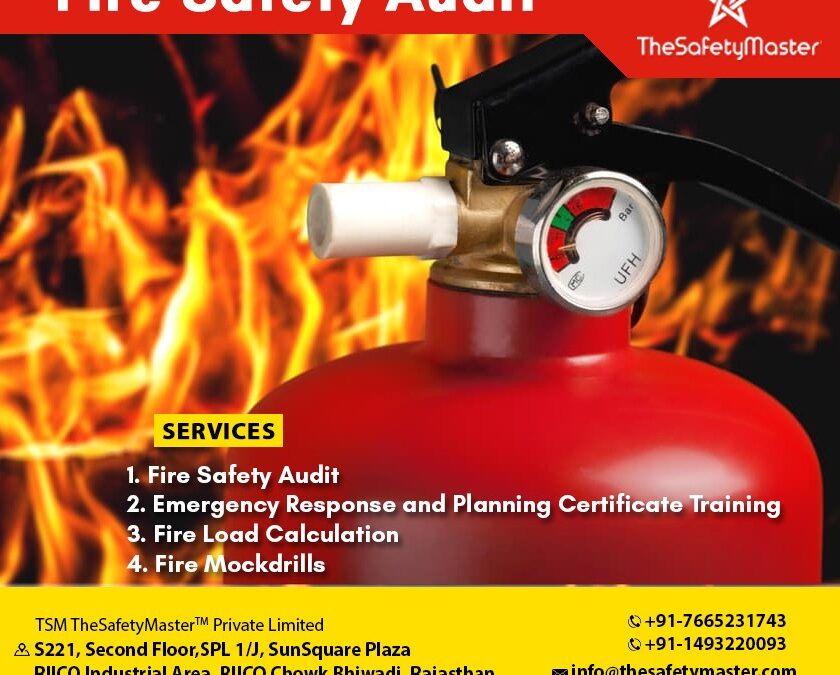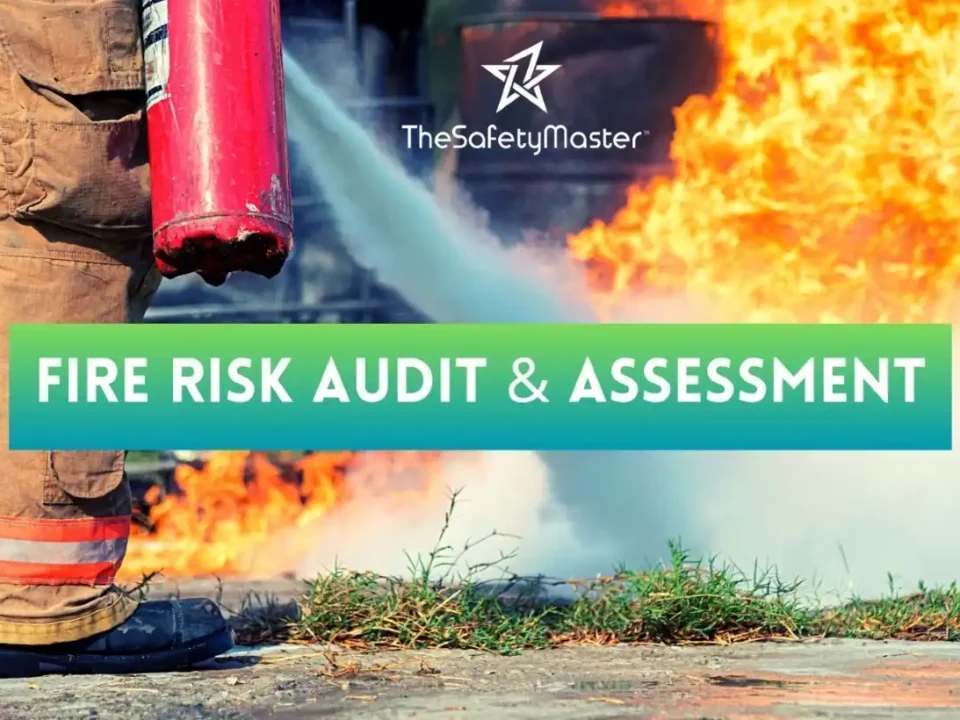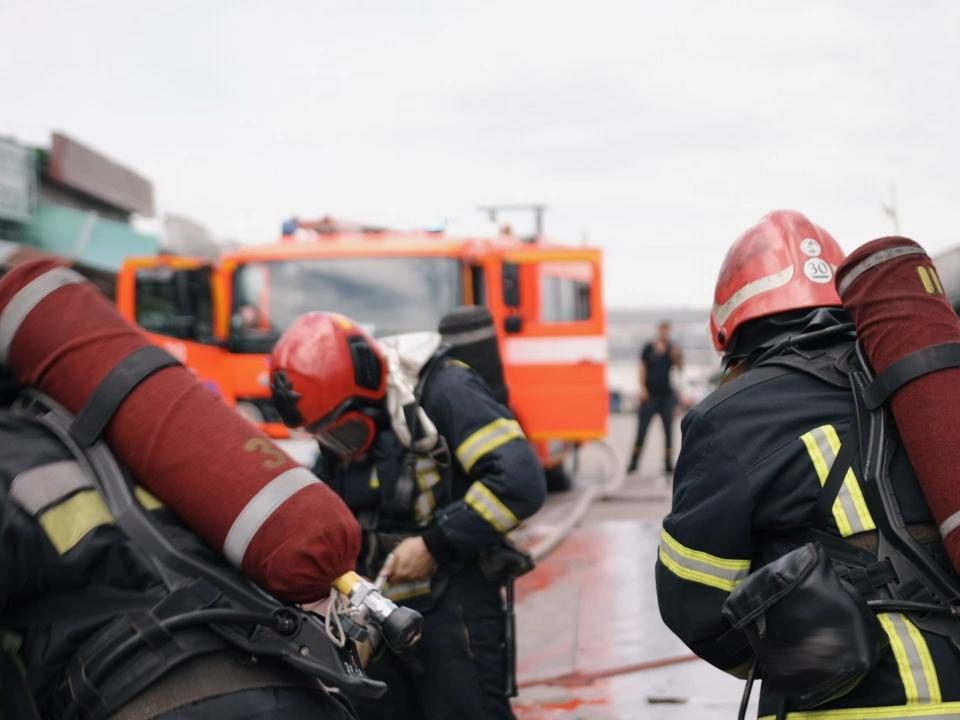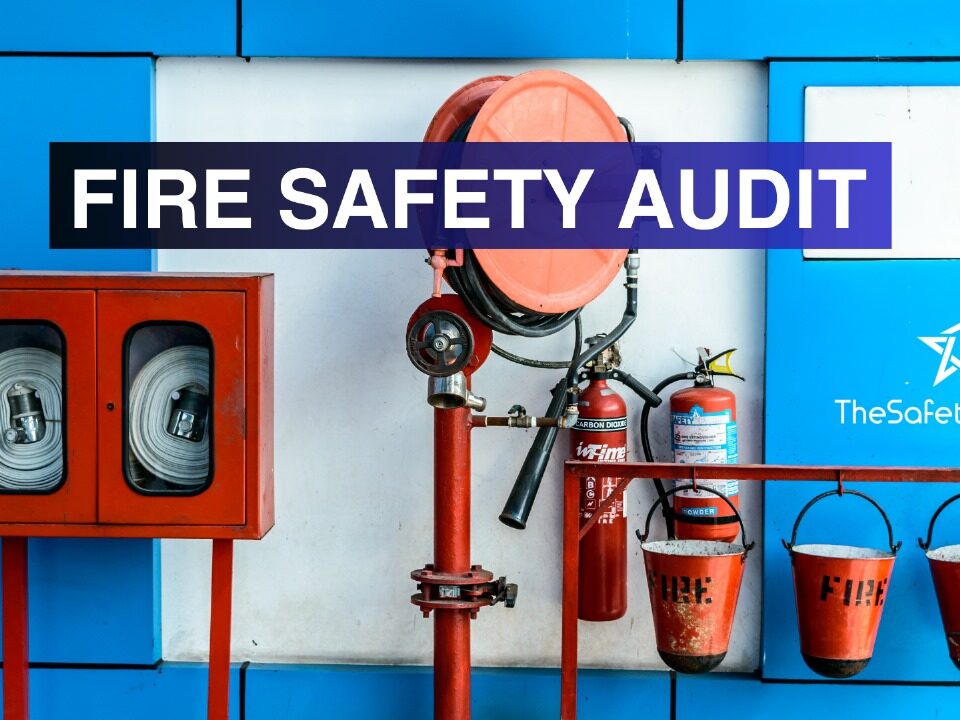Fire Audit of building or manufacturing units

Navigating Regulatory Requirements in Electrical Safety Audit
March 17, 2025
Leadership Role in Safety Success: Unveiling the Effectiveness of Behaviour-Based Safety Training in Indian Industries
March 26, 2025Fire Audit of building or manufacturing units
Fire safety is a crucial aspect of any environment, be it a residential property, workplace, or public space. The devastating consequences of fires are well-known, making it imperative for individuals and organizations to prioritize fire prevention and preparedness. In this comprehensive article on Fire Audit, we will delve into the essential steps required to ensure optimal fire safety in any setting. Whether you are a homeowner seeking to safeguard your family or a business owner aiming to protect your employees and assets, this article will provide you with valuable insights and practical strategies.
As we embark on this journey together, expect to gain a deep understanding of the importance of fire safety and the potential hazards that may exist within your surroundings. We will explore how to identify these risks through a thorough assessment process and create an effective emergency action plan tailored to your specific needs. Moreover, we will highlight the significance of equipping your space with appropriate fire safety equipment and conducting regular drills to ensure everyone is well-prepared in case of an emergency.
By the end of this enlightening article, you can rest assured that you will possess valuable knowledge about fire safety regulations in different environments. Furthermore, through analysis of successful case studies and best practices from various industries, we aim not only to educate but also inspire you towards implementing robust fire safety measures. Together, let us cultivate a culture that prioritizes prevention over reaction when it comes to the threat of fires.
Understanding the Importance of Fire Safety
Fire safety is an indispensable aspect of any environment, be it residential, commercial, or industrial. Understanding its significance not only protects lives but also safeguards property and ensures the continuity of business operations. A fire can devastate everything in its path, leaving behind irreparable damage and causing immeasurable loss.
By comprehending the importance of fire safety, we acknowledge our responsibility to create a safe and secure environment for ourselves and those around us. It is not merely a legal obligation but a moral imperative to prioritize fire prevention measures. Properly implemented fire safety practices not only minimize the risk of fires occurring but also reduce their potential impact by enabling swift evacuation and effective firefighting.
The Start of Your Fire Audit Journey
Embarking on a fire audit is a proactive step towards ensuring the safety and well-being of your space and its occupants. It marks the beginning of a comprehensive process that aims to identify potential fire hazards, assess current safety measures, and implement necessary improvements. This journey is not just about compliance; it’s about fostering a culture of fire safety and protection.
As you embark on this journey, enthusiasm coupled with meticulousness will be your guiding lights. Start by familiarizing yourself with relevant fire safety codes and regulations specific to your region or industry. Gain insight into the potential hazards that may exist in your setting, such as flammable materials or outdated electrical systems.
Assessing Potential Fire Hazards
In order to effectively manage fire safety, it is crucial to conduct a thorough assessment of potential fire hazards within your space. Take a meticulous approach and leave no stone unturned, for even the smallest oversight can have devastating consequences. Begin by examining the layout and structure of your premises.
Identify any flammable materials or substances that could pose a risk, paying close attention to storage areas, electrical systems, and heating equipment. Check for faulty wiring or overloaded sockets, as electrical malfunctions are one of the primary causes of fires. Remember to also assess your ventilation systems, as poor airflow can escalate fire hazards significantly.
Furthermore, evaluate your inventory and identify any potentially hazardous materials that may be present in your workspace. Whether it’s chemicals used for cleaning purposes or highly combustible substances utilized in production processes, it is imperative to store them appropriately and ensure proper handling procedures are in place.
By diligently assessing potential fire hazards within your premises, you not only minimize the risk of a fire outbreak but also create a safer environment for everyone involved. This diligent effort will contribute towards fostering an atmosphere where employees feel secure and customers trust in the reliability of your business.
Creating an Emergency Action Plan
In the realm of fire safety, preparation is key. It is imperative to have a well-crafted Emergency Action Plan (EAP) in place, ensuring that all individuals within your space will know exactly what to do in the event of a fire. The EAP serves as a comprehensive guide, outlining the necessary steps and procedures to be followed during an emergency situation.
When crafting an effective EAP, it is crucial to consider your specific environment and tailor the plan accordingly. Start by identifying potential escape routes and ensuring they are easily accessible and well-marked. Designate assembly points where individuals should gather after evacuating the premises, allowing for easy headcount and efficient communication.
Equipping Your Space with Fire Safety Equipment
When it comes to ensuring the safety of your space, equipping it with the right fire safety equipment is of paramount importance. A well-prepared and properly equipped environment can significantly reduce the risk of a fire turning into a disaster. To fortify your defense against potential flames, start by installing smoke detectors throughout your premises. These vigilant sentinels will swiftly detect any signs of smoke, alerting you and your team to take necessary actions.
In addition to smoke detectors, fire extinguishers should be strategically placed in easily accessible areas. These powerful tools are indispensable in swiftly extinguishing small fires before they escalate into unmanageable infernos. It is vital to have an adequate number of fire extinguishers, ensuring that they are regularly inspected and maintained according to industry standards. Remember, when it comes to protecting lives and property from fire hazards, it is always better to have multiple layers of defense than relying solely on one piece of equipment.
Conducting Regular Fire Drills
Fire drills are not just exercises in routine; they are critical components of a comprehensive fire safety strategy. Regularly conducting fire drills ensures that everyone in your space is well-prepared and knows exactly what to do in the event of a fire emergency. It allows you to test the effectiveness of your emergency action plan and identify any areas for improvement.
During a fire drill, it is crucial to simulate real-life scenarios as closely as possible. Inform all occupants about the upcoming drill in advance, without revealing specific details about the timing. This will help create a realistic sense of urgency and ensure that individuals respond genuinely. Designate an appointed person, such as a fire warden or safety officer, to coordinate and oversee the drill. They should communicate clear instructions on evacuation routes, assembly points, and any additional safety measures.
Educating and Fire Fighting Training Your Team
When it comes to fire safety, knowledge is power. Educating and training your team members about fire prevention and emergency procedures is crucial in ensuring a safe working environment. Start by conducting comprehensive training sessions that cover the fundamentals of fire safety, such as identifying potential hazards, proper use of firefighting equipment, and evacuation protocols.
Engage your team in interactive workshops, where they can actively participate in fire drills and simulations. This hands-on approach not only reinforces their understanding but also instills a sense of confidence in handling emergencies. Foster a culture of awareness by regularly sharing educational resources, such as informative articles or engaging videos, to keep the topic fresh in everyone’s minds.
Staying Up to Date with Fire Safety Regulations
As the world continues to evolve, so do the regulations governing fire safety. It is imperative for businesses and organizations to stay informed and comply with the latest guidelines. This not only ensures the safety of your premises but also demonstrates your commitment to protecting lives and property.
To stay up to date with fire safety regulations, it is essential to establish a system that monitors any changes or updates in applicable laws. Regularly review local, state, and national codes pertaining to fire safety and ensure that your fire prevention measures align with these standards. Engage with professional organizations, attend seminars or webinars on fire safety, and consider joining industry groups that provide updates on regulatory changes.
Assessing Fire Safety in Different Environments
When it comes to fire safety, it is crucial to understand that each environment presents its own unique set of challenges. Whether you are assessing fire safety in a residential building, a commercial office space, or an industrial facility, thorough evaluation is essential.
In residential buildings, focus on ensuring that smoke alarms are installed in every room and regularly tested. Educate residents on proper fire prevention practices and provide clear evacuation routes. Additionally, consider the specific needs of vulnerable individuals such as children or the elderly and implement measures to address their safety concerns.
In commercial office spaces, conduct a comprehensive examination of electrical systems, including wiring and outlets. Implement strict policies regarding flammable materials storage and enforce regular inspections of potential ignition sources like kitchen areas or break rooms. Educate employees about fire extinguisher usage and make sure there are clear exit signs visible throughout the office.
Industrial facilities present their own unique challenges due to the presence of hazardous materials and complex machinery. Assess ventilation systems to prevent the buildup of flammable vapors or gases. Implement robust fire suppression systems that cater specifically to the nature of operations conducted within your facility. Ensure all employees undergo rigorous training on emergency response procedures tailored to their specific work environments.
Remember, assessing fire safety in different environments requires attention to detail and understanding of the risks involved in each setting. By tailoring your approach accordingly, you can create a safe environment for all occupants while cultivating peace of mind.
Implementing Best Practices from Successful Case Studies
In the realm of fire safety, learning from successful case studies can provide valuable insights and guidance for implementing best practices. By analyzing real-life scenarios where fire audits have been effectively conducted, organizations can gain inspiration and practical strategies to enhance their own fire safety measures.
One notable case study is the success story of Company XYZ, a manufacturing facility that underwent a comprehensive fire audit. Through meticulous planning and execution, the company was able to identify potential fire hazards specific to their industry and implement proactive measures to mitigate them. By conducting regular equipment maintenance, installing state-of-the-art fire suppression systems, and training employees on safe handling procedures, Company XYZ achieved remarkable results. Not only did they significantly reduce the risk of fires but also saw a boost in overall productivity due to enhanced employee confidence and peace of mind.
Conclusion
In conclusion, undertaking a comprehensive fire audit is not just a legal obligation, but a crucial step towards safeguarding lives and protecting valuable assets. By diligently assessing potential fire hazards, creating an effective emergency action plan, equipping your space with the necessary safety equipment, conducting regular drills, and ensuring your team is well-trained and educated on fire safety protocols, you can significantly reduce the risk of fire-related incidents. Remember that staying up to date with fire safety regulations and implementing best practices from successful case studies will enhance your preparedness even further. Embracing these practices will undoubtedly instill confidence in your stakeholders while fostering a secure environment that prioritizes safety above all else.
With Best Wishes
Sanjeev Paruthi
TSM TheSafetyMaster® Private Limited
Unit No 221-451-452, SPL1/J, 2nd & 4th Floor, Sunsquare Plaza Complex, RIICO Chowk, Bhiwadi 301019, Rajasthan, India
Phone: +91 1493 22 0093
Mobile: +91 7665231743/9413882016
Email: info@thesafetymaster.com




